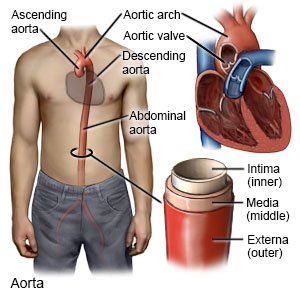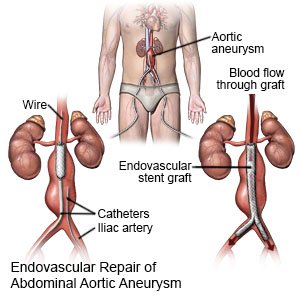Evar (Endovascular Aortic Aneurysm Repair)
Medically reviewed by Drugs.com. Last updated on Apr 6, 2025.
What is an endovascular aortic aneurysm repair (EVAR)?
EVAR is a procedure to prevent an abdominal aortic aneurysm from rupturing (bursting).
 |
How do I prepare for a planned EVAR?
- Your healthcare provider will talk to you about how to prepare for your procedure. You may be told not to eat or drink anything after midnight on the day of your procedure. Arrange to have someone drive you home and stay with you after your procedure.
- You may need blood tests, an ultrasound, or a CT angiography scan before your procedure. These tests will help your provider plan for your procedure. Talk to your provider about these or other tests you may need.
- Tell your provider about all your current medicines. Your provider will tell you if you need to stop any medicine for the procedure, and when to stop. You may need to stop taking blood thinning medicine several days before your procedure. Your provider will tell you which medicines to take or not take on the day of your procedure.
- Tell your provider about any allergies you have, including to medicines or anesthesia. You may be given an antibiotic or contrast liquid during your procedure. Tell your provider if you have ever had an allergic reaction to antibiotics or contrast liquid.
Drugs used to treat this and similar conditions
Metoprolol
Metoprolol is used to treat angina (chest pain) and hypertension (high blood pressure). Learn about ...
What will happen during EVAR?
- You may be given local anesthesia to numb the catheter sites. With local anesthesia, you may still feel pressure or pushing, but you should not feel pain. You may instead be given general anesthesia to keep you asleep and free from pain during your procedure.
- Your healthcare provider will insert a catheter into an artery on each side of your groin. A wire and stent-graft will be guided through each catheter and up into your abdominal aorta. A stent-graft is a long tube covered with metal mesh. The wire helps get the stent-graft to the correct place. Your provider may inject contrast liquid so your blood vessels will show up more clearly in x-rays.
- Your provider will inflate a balloon inside the stent-graft to push it against the artery wall. The mesh has hooks that help hold the stent-graft in place. Blood will flow through the stent-graft instead of to the aneurysm. This will decrease pressure on the aneurysm and lower the risk for a rupture.

- Your provider will remove the catheters and wires. Clamps, stitches, or other devices will be used to close the catheter sites. Pressure will be applied to each site for several minutes to stop any bleeding. A pressure bandage or other pressure device may be placed over each site. This will help prevent more bleeding.
What should I expect after EVAR?
- You will be attached to a heart monitor until you are fully awake. A heart monitor is an EKG that stays on continuously to record your heart's electrical activity. You will spend 1 to 2 days in the hospital.
- You will need to lie flat with your legs straight for 2 to 4 hours. Do not get out of bed until your healthcare provider says it is okay. Leg movements can cause serious bleeding.
- Healthcare providers will monitor your vital signs and pulses in your legs. They will check your pressure bandages for bleeding or swelling.
- You may have pain and bruising where the catheters were placed. Medicines may be given to prevent or treat pain, a blood clot, or a bacterial infection.
- You will need ongoing tests to check the graft position and size of your aneurysm.
What are the risks of EVAR?
You may bleed more than expected or develop an infection. You may need surgery to repair damage to your blood vessels from the catheter. You may also need surgery to stop bleeding. The graft may move out of place or leak blood into your aneurysm. A leak may need to be treated. You may develop a blood clot in your leg. A blood clot may block the graft and decrease blood flow through your abdominal aorta. The graft or catheter may stop blood flow to your legs. Even with EVAR, your aneurysm may rupture and cause life-threatening bleeding. You may need more than 1 EVAR.
Care Agreement
You have the right to help plan your care. Learn about your health condition and how it may be treated. Discuss treatment options with your healthcare providers to decide what care you want to receive. You always have the right to refuse treatment. The above information is an educational aid only. It is not intended as medical advice for individual conditions or treatments. Talk to your doctor, nurse or pharmacist before following any medical regimen to see if it is safe and effective for you.© Copyright Merative 2025 Information is for End User's use only and may not be sold, redistributed or otherwise used for commercial purposes.
Further information
Always consult your healthcare provider to ensure the information displayed on this page applies to your personal circumstances.
